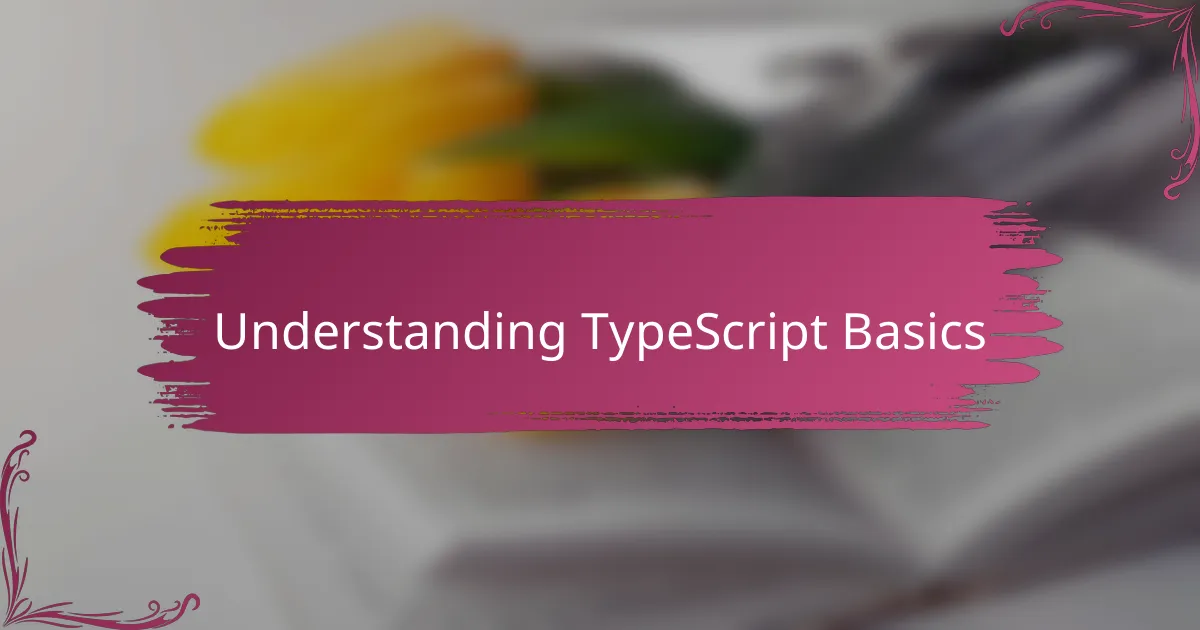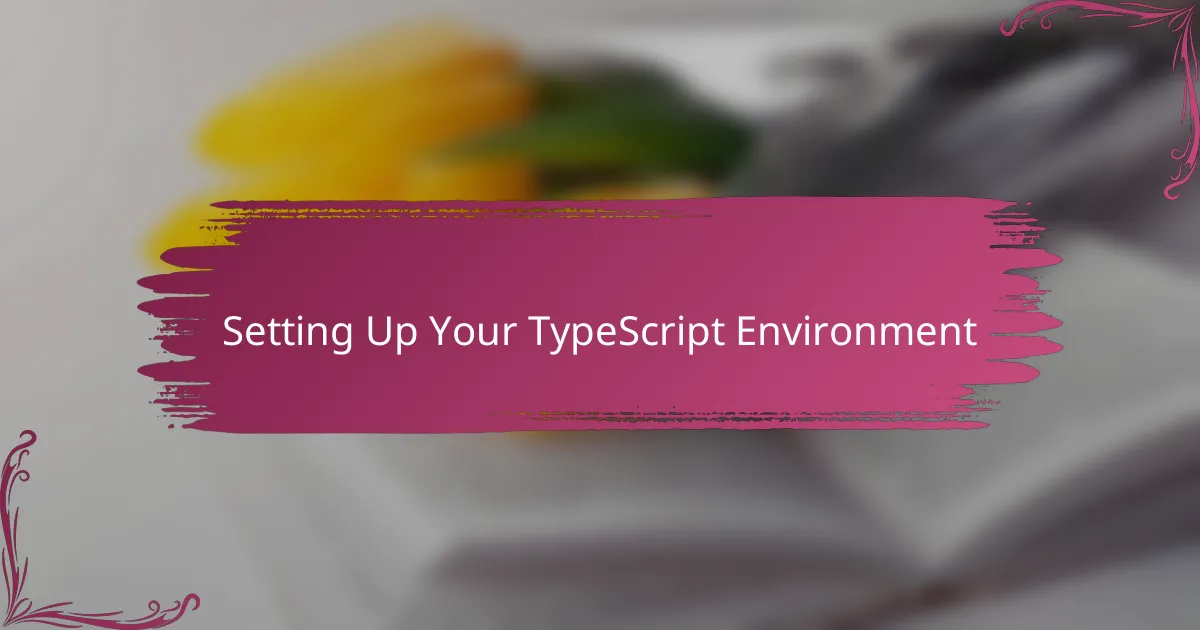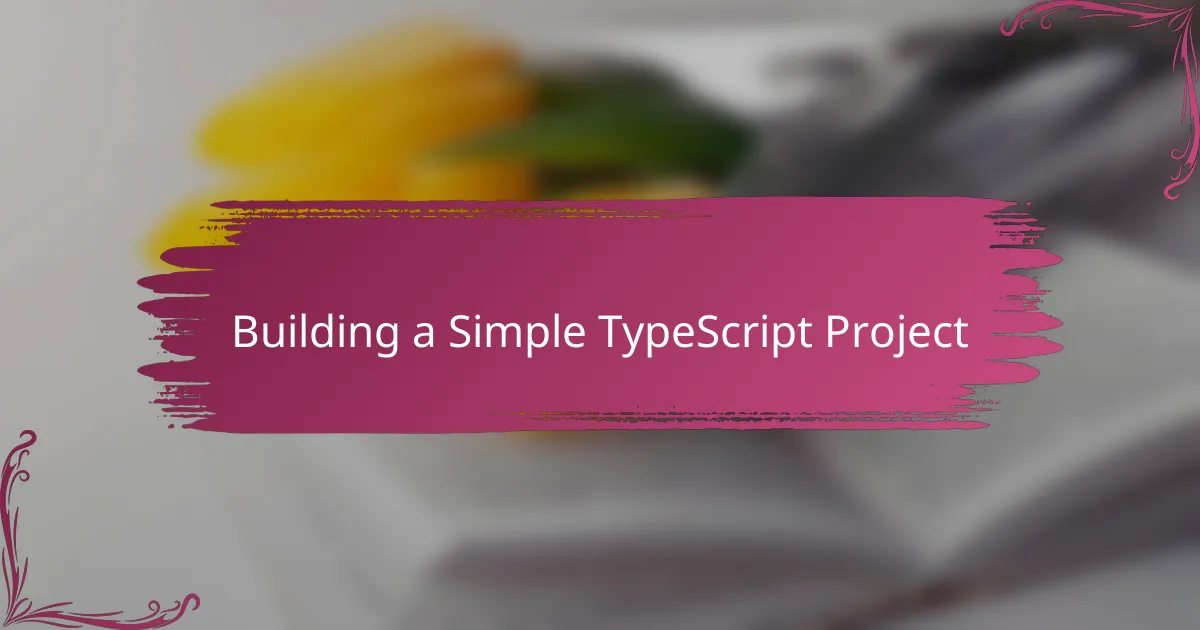Key takeaways
- TypeScript enhances code quality with static typing, catching errors early and improving readability and maintainability.
- Type inference and union types provide flexibility and safety, allowing cleaner code without excessive annotations.
- Integrating TypeScript with a supportive code editor significantly speeds up the learning process and improves coding efficiency.
- Setting small, achievable goals and engaging in hands-on practice are crucial strategies for mastering TypeScript concepts effectively.

Understanding TypeScript Basics
When I first started with TypeScript, the idea of adding types to JavaScript felt both exciting and a bit intimidating. Understanding that TypeScript is essentially JavaScript with a type system helped me see it as a tool for catching errors early, rather than an extra burden. Have you ever made a silly typo in your code that took hours to find? TypeScript’s static typing saved me countless headaches by pointing those out immediately.
One of the fundamentals I focused on was learning how to declare types for variables, functions, and objects. At first, it felt like a small hurdle—writing out type annotations—but soon, it became clear how much it improved code readability and maintainability. It’s like having a safety net that lets you experiment confidently since you know TypeScript has your back.
I also appreciated discovering interfaces and how they help define the shape of objects. This was a turning point where TypeScript moved from feeling like an added step to becoming an indispensable part of my coding workflow. Have you tried modeling real-world data with interfaces? It’s satisfying to see your code align precisely with your intentions.

Setting Up Your TypeScript Environment
Getting my TypeScript environment up and running was simpler than I expected, but it definitely required some initial patience. I installed Node.js first, since TypeScript relies on it to run smoothly, and then I used npm to install the TypeScript compiler globally. Have you ever felt stuck trying to configure your tools? That moment when everything clicks after a few commands felt pretty rewarding.
After installation, I created a basic tsconfig.json file to customize how TypeScript compiles my code. This step gave me control over strictness settings and output directories — it was like tuning an engine to get the exact performance I wanted. I found that tweaking these options early helped me avoid confusion later, especially when projects started growing more complex.
One thing I learned personally is that integrating TypeScript with your favorite code editor makes a huge difference. Using Visual Studio Code, I enabled its built-in TypeScript support, which provided real-time feedback and auto-completion that sped up my learning process significantly. If you’re not using an editor with TypeScript integration, I’d definitely recommend giving it a try—your future self will thank you.

Key TypeScript Concepts Explained
One key concept that really clicked for me was understanding TypeScript’s type inference. At first, I thought I’d have to annotate every single variable myself, but I soon saw how TypeScript can guess types based on the value assigned. Isn’t it amazing how this balance between explicit annotations and inference keeps code clean without sacrificing safety?
Another important idea I encountered was union types—allowing a variable to hold multiple types. I remember hesitating at first, wondering if this would complicate things, but it actually gave me flexibility while still keeping errors in check. Have you ever needed a variable to accept either a string or a number? Union types solve that elegantly.
Finally, generics opened a whole new world for me. At first, they seemed intimidating with their angle brackets and abstract syntax. But once I wrapped my head around the concept of writing reusable, type-safe functions and classes, it felt like discovering a superpower. Don’t you love when a once-confusing idea suddenly becomes your favorite tool?

Common Challenges and Solutions
One challenge I faced early on was dealing with strict type errors that seemed overwhelming at first. I remember staring at red squiggly lines wondering if I broke everything—but then I realized these errors were actually guiding me to write better, safer code. Have you ever felt frustrated by error messages that actually push you toward mastering a new skill? That’s exactly what TypeScript’s strictness did for me.
Another tricky part was figuring out how to integrate third-party JavaScript libraries that didn’t come with TypeScript typings. It felt like trying to fit a square peg in a round hole, but I found that leveraging @types packages or writing custom declaration files made this much smoother. Once I tackled this, it felt like unlocking a door to a whole ecosystem rather than being shut out.
Sometimes, I struggled with balancing when to rely on TypeScript’s type inference versus when to explicitly annotate types. Early on, I over-annotated my code, which made it verbose and hard to maintain. Learning to trust TypeScript’s inference, while adding annotations selectively, was like finding a rhythm in my coding—less noise, more clarity. Have you found that sweet spot yet? It certainly took me some trial and error.

Building a Simple TypeScript Project
Starting my first TypeScript project was both thrilling and a little nerve-wracking. I began by writing a simple script—a to-do list app—just to see how types would fit into my usual JavaScript flow. Did I really need to declare every variable’s type explicitly? Surprisingly, I found that even minimal typing made my code much clearer and reduced those pesky runtime errors.
Configuring the project’s structure was another learning curve. I set up a basic tsconfig.json to control how TypeScript compiled my files and organized the output into a “dist” folder. This felt empowering, almost like I was customizing the build process to suit my needs, which made me appreciate TypeScript’s flexibility even more.
One moment that stood out was when I added interfaces to define the shape of my to-do items. Suddenly, my functions were less about guessing and more about strictly following a blueprint. It was satisfying to see TypeScript catch mismatches before I even ran the code. Have you ever experienced that “aha” feeling when your code starts guiding you instead of you chasing bugs? That’s when TypeScript truly became my coding ally.

Practical Tips for Learning TypeScript
What really helped me was setting small, achievable goals each day instead of trying to learn everything at once. I remember feeling overwhelmed early on—so breaking concepts into bite-sized pieces made TypeScript feel less like a beast and more like a puzzle I could solve step by step. Have you tried focusing on just one feature, like interfaces or enums, before moving on? It really builds confidence.
I also made it a habit to write a lot of code, not just read about the features. Hands-on practice, like tweaking samples or converting JavaScript snippets, helped the ideas stick. Nothing beats the moment when you realize your TypeScript code just works flawlessly—those wins kept me motivated through the tricky parts.
Another tip: don’t shy away from using community resources like DefinitelyTyped or playgrounds for experimentation. When I was stuck, testing types in the official playground made concepts click faster than any documentation alone. Have you played around with the TypeScript playground yet? It’s a sandbox that saved me endless frustration.

Reflecting on My Learning Journey
Looking back, I realize how much my mindset shifted during this journey. At first, I saw TypeScript as just another set of rules to follow, but it gradually became a partner that helped me write cleaner, more reliable code. Have you ever experienced that moment when frustration turns into appreciation? That’s exactly how I felt when errors stopped being roadblocks and started becoming learning checkpoints.
There were definitely times I doubted if I’d ever fully grasp the concepts, especially when generics or strict types seemed like a different language altogether. But each small breakthrough—like seeing a compiler error save me from a silly bug—felt like a victory that kept me going. Don’t you find that these little wins often mean the most in learning?
Reflecting on it all, I understand now that patience and persistence were my best allies. I didn’t master everything overnight, but by embracing the challenges and leaning into the process, TypeScript stopped feeling intimidating and became a tool I genuinely enjoy using every day. How often do you get to say that about something you once found difficult?